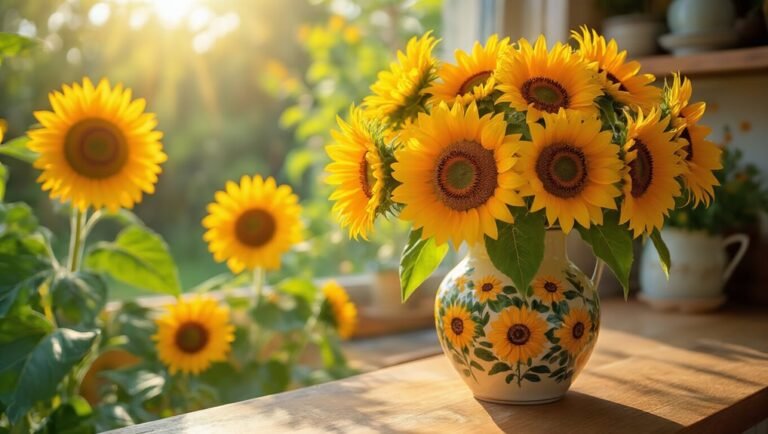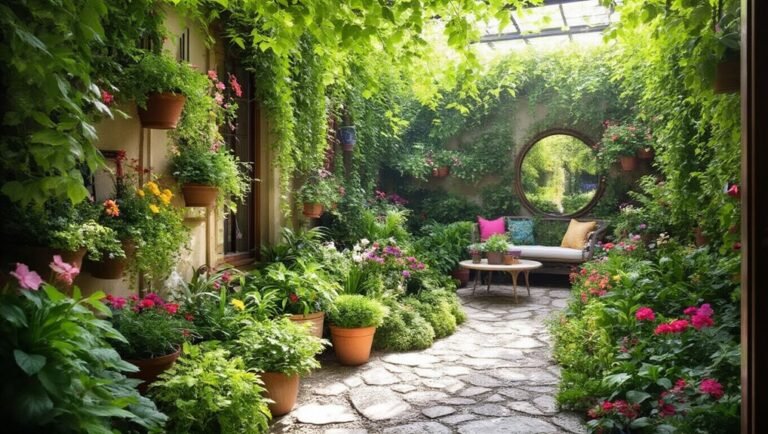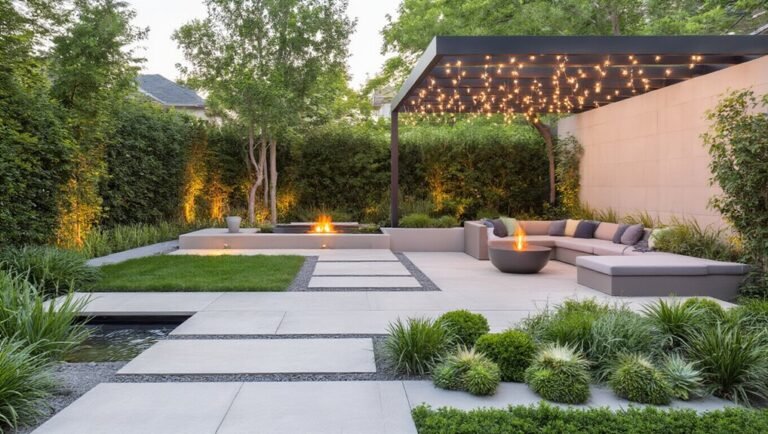To create a stunning low-maintenance backyard garden, start by choosing drought-resistant plants like lavender and succulents. Incorporate perennials for year-round beauty with staggered bloom times. Design hardscaping elements, such as pathways or raised beds, for structure. Use mulch to suppress weeds and retain moisture effortlessly. If you prefer a zen garden, gravel and hardy plants require minimal upkeep. Don’t forget about low-maintenance edible plants to add flavor and beauty. There’s even more to discover!
Key Takeaways
- Choose drought-resistant plants like lavender and succulents to minimize watering and maintenance while creating a visually appealing landscape.
- Incorporate a variety of perennials that bloom at different times for continuous color throughout the year.
- Use hardscaping elements such as pathways and raised beds to reduce mud and define spaces, adding structure to your garden.
- Apply mulch to suppress weeds, retain moisture, and regulate soil temperature, ensuring a healthier garden with less upkeep.
- Design a Zen garden with gravel, rocks, and hardy plants for a serene, low-maintenance outdoor space that requires minimal attention.
Choosing Drought-Resistant Plants
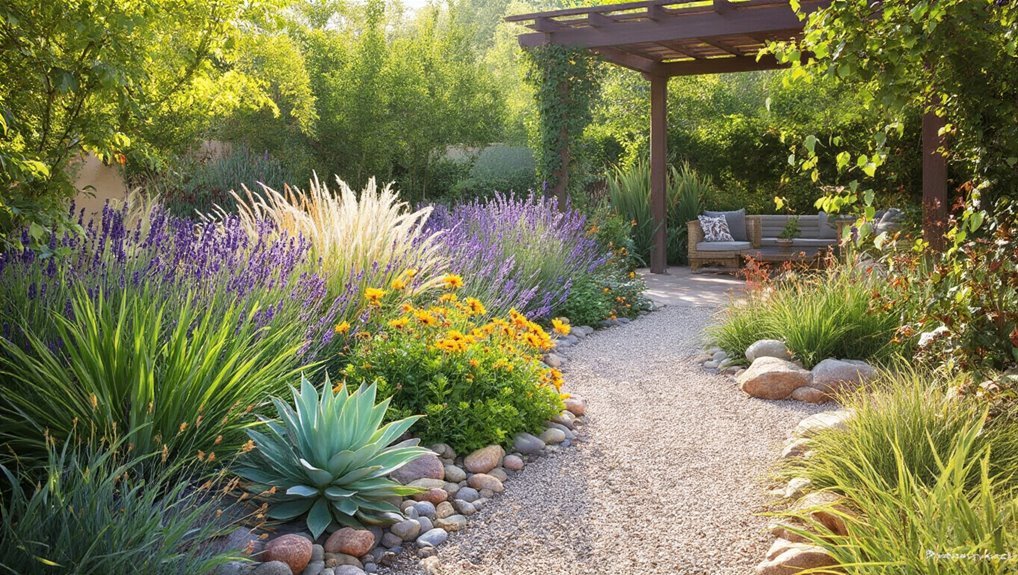
When you’re planning your backyard garden, choosing drought-resistant plants can make a significant difference, especially during dry spells.
These hardy plants not only conserve water but also thrive in challenging conditions. Consider options like lavender, succulents, or native grasses that adapt well to dry environments. They require minimal maintenance, freeing up your time for other gardening tasks. For an extra splash of color and functionality, try incorporating edible flower seeds into your garden design, as many varieties are both beautiful and resilient.
Grouping these plants together can create a stunning visual impact while ensuring they receive the same watering needs. Don’t forget to incorporate mulch; it helps retain moisture and suppresses weeds.
You might also consider adding insect repellent plants to your garden, as they can naturally help keep pests at bay while complementing your low-maintenance landscape.
Incorporating Perennials for Year-Round Beauty
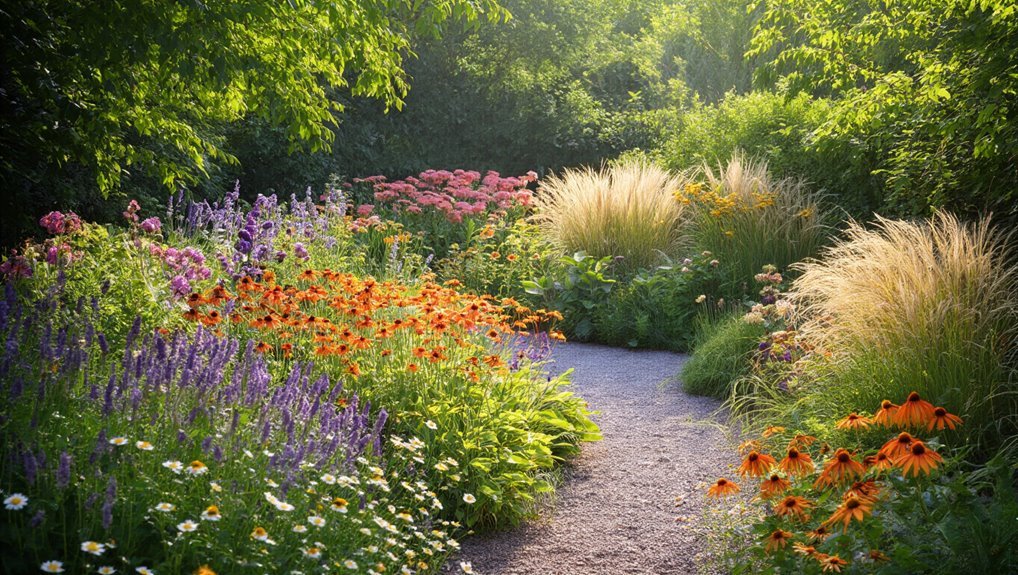
Adding perennials to your garden can enhance its beauty throughout the year, providing a colorful and dynamic landscape that evolves with the seasons.
Choose a variety of perennials that bloom at different times to ensure you have something flowering from spring through fall. For instance, you might plant early bloomers like daffodils and tulips, followed by summer favorites like coneflowers and daylilies. In the fall, consider asters and sedums for their vibrant hues. For gardeners seeking both aesthetic appeal and practicality, raised garden beds can help organize perennials and improve soil quality.
Additionally, perennials often require less maintenance than annuals, allowing you more time to enjoy your garden. Incorporate different heights and textures to create visual interest.
For even easier care and versatility, consider using grow bags as they offer excellent drainage and can be moved to suit your garden’s changing needs.
With the right selection, your garden will remain lively and inviting, showcasing nature’s beauty year-round.
Designing With Hardscaping Elements
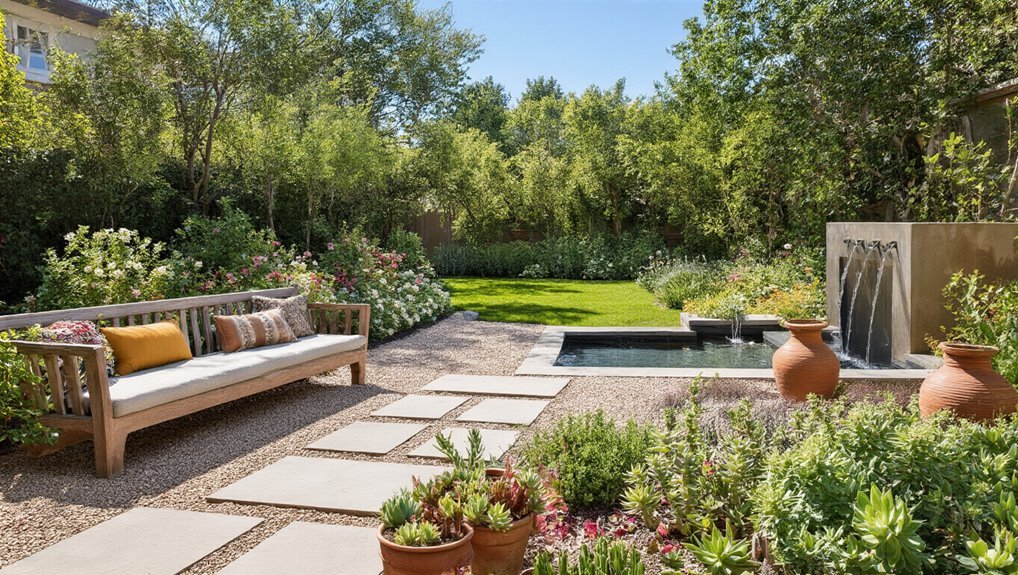
While plants bring life to your garden, hardscaping elements provide structure and functionality, creating a balanced outdoor space.
Incorporate pathways made of stone, gravel, or pavers to guide visitors through your garden while minimizing mud and maintenance. For anyone who regularly hauls tools, mulch, or debris, garden carts are an essential addition to make transport easier and more efficient in your backyard.
Consider raised beds or retaining walls for a visually appealing way to define areas and elevate your plantings.
Patios or decks extend your living space outdoors, perfect for gatherings or quiet relaxation.
Add benches or decorative boulders for seating that blends seamlessly with nature.
Lastly, think about including fire pits or water features, which add ambiance and focal points, enhancing your garden’s overall appeal.
When tackling larger landscaping projects, having the right wheelbarrows can make transporting materials like soil, gravel, or stones much easier and more efficient.
Utilizing Mulch for Weed Control
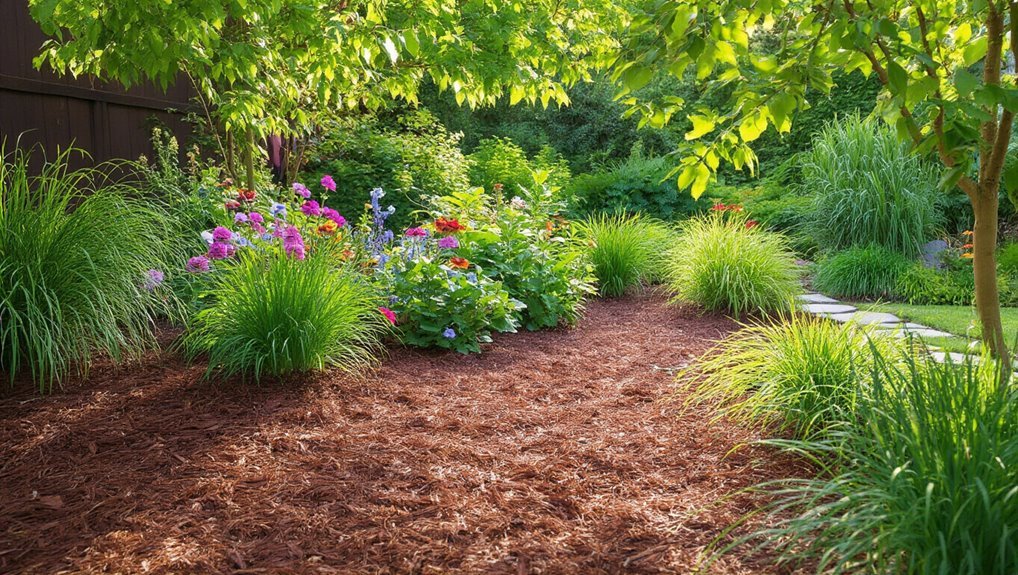
To keep your garden looking its best, utilizing mulch for weed control is a smart strategy. Mulch acts as a barrier, blocking sunlight and preventing weed seeds from germinating. You can choose from various types, like wood chips, straw, or shredded leaves, depending on your garden’s aesthetic and your budget. Organic mulching materials such as straw not only help with weed control but are also environmentally friendly and break down naturally over time. Apply a layer about 2-3 inches thick around your plants, ensuring you keep it away from the stems to avoid rot.
Not only does mulch suppress weeds, but it also retains moisture and regulates soil temperature, making your garden healthier overall. Plus, it adds a polished look to your landscape.
Regularly check and replenish your mulch as needed, and you’ll enjoy a beautiful, low-maintenance garden. For even more benefits, mulch can improve soil health by breaking down over time and adding organic matter to your garden beds.
Creating a Zen Garden for Minimal Maintenance
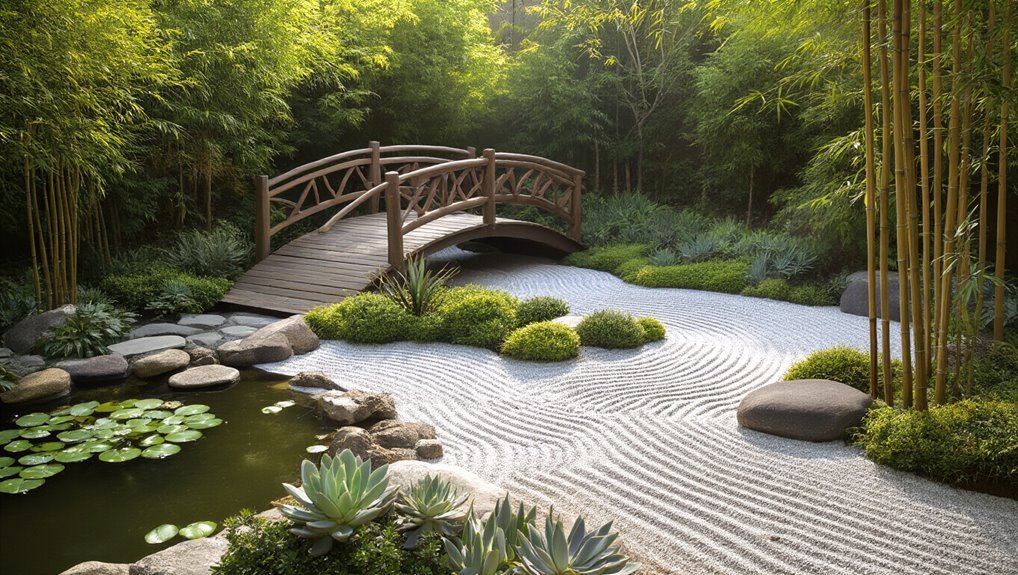
Creating a Zen garden offers a serene escape that requires minimal upkeep, making it an ideal choice for busy gardeners. You can further enhance your space by incorporating Herb Garden Kits with Seeds and Pots, which allow you to grow fresh, aromatic herbs while keeping maintenance easy and contained.
To create your low-maintenance oasis, follow these simple steps:
- Choose gravel or sand: These materials require no watering and help with drainage.
- Incorporate rocks: Use larger stones as focal points and smaller ones to outline paths, adding texture without needing care.
- Select hardy plants: Opt for drought-resistant options like succulents or ornamental grasses that thrive with little attention.
- Add simple structures: Incorporate a bench or a small water feature for tranquility without the hassle of maintenance.
If you decide to grow plants from seed, using Seedling Heat Mats can help ensure strong and healthy germination even in cooler climates.
With these elements, you’ll create a calming space that invites relaxation and minimizes the demands of gardening.
Adding Low-Maintenance Edible Plants
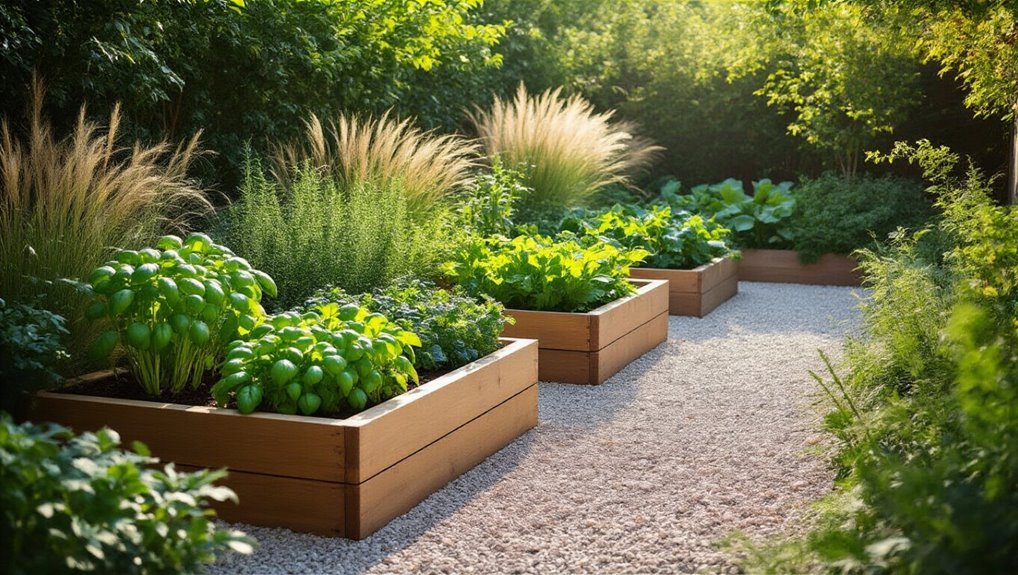
How can you enjoy fresh produce without spending hours in the garden? By choosing low-maintenance edible plants, you can create a productive garden with minimal effort.
Consider growing herbs like basil, chives, or mint. They thrive in various conditions and require little care. For vegetables, try cherry tomatoes or radishes; they grow quickly and don’t need much attention. If you’re starting your plants from seed, using a seed starting kit can make the process easier and more successful.
Opt for perennial plants like asparagus or rhubarb, which come back year after year. Plant them in raised beds or containers to simplify maintenance.
You’ll also appreciate fruiting plants like strawberries or blueberries, which can add beauty and flavor to your space.
If you enjoy cultivating specialty plants, consider exploring orchid care supplies that help orchids thrive with minimal upkeep.
With these options, you’ll relish the joys of gardening while enjoying fresh, homegrown produce effortlessly!
Frequently Asked Questions
What Are the Best Tools for Low-Maintenance Gardening?
For low-maintenance gardening, you’ll want quality tools like a sturdy hand trowel, ergonomic pruners, a durable garden fork, and a reliable hose. These essentials make your gardening tasks easier and more efficient, saving you time and effort.
How Can I Attract Pollinators to a Low-Maintenance Garden?
To attract pollinators to your garden, plant native flowers, avoid pesticides, and create diverse habitats. Incorporating flowering herbs and shrubs also helps, as well as providing water sources for bees and butterflies. They’ll thrive!
Are There Any Low-Maintenance Garden Design Trends to Consider?
Absolutely! You should consider trends like native plants, xeriscaping, and vertical gardens. These designs not only minimize upkeep but also create stunning visual appeal, ensuring your garden thrives with less effort while supporting local ecosystems.
How Often Should I Water a Low-Maintenance Garden?
You should water your low-maintenance garden about once a week, adjusting based on rain and temperature. Early mornings or late afternoons are best; this helps plants absorb moisture before the sun evaporates it.
What Pests Should I Watch for in a Low-Maintenance Garden?
You might think your garden’s safe, but pests lurk. Watch for aphids, spider mites, and slugs. They can sneak in and wreak havoc if you’re not vigilant. Stay alert to keep your garden thriving!
Conclusion
With a little creativity and the right choices, your backyard can bloom into a stunning oasis without demanding your time. By selecting drought-resistant plants, incorporating hardy perennials, and embracing hardscaping, you’re crafting a serene retreat that thrives on simplicity. Picture a lush garden that whispers tranquility, inviting you to unwind. So, roll up your sleeves and transform your outdoor space into a low-maintenance paradise, where beauty flourishes effortlessly, and every glance feels like a breath of fresh air.
